Seat Exeo ST 2012 Owner's manual
Manufacturer: SEAT, Model Year: 2012, Model line: Exeo ST, Model: Seat Exeo ST 2012Pages: 325, PDF Size: 5.56 MB
Page 261 of 325
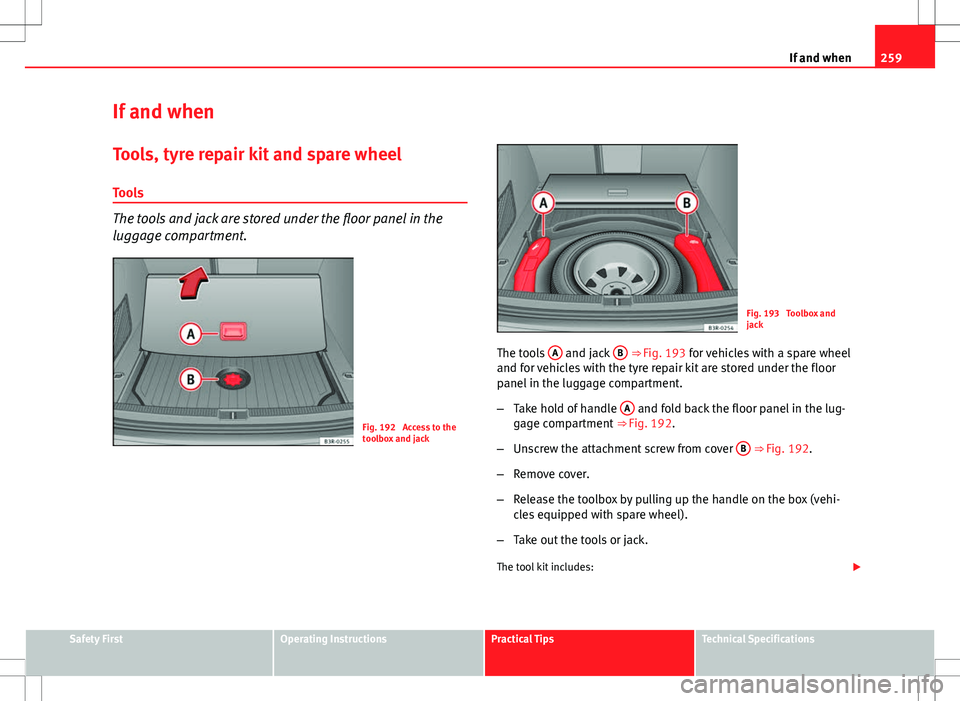
259
If and when
If and when
Tools, tyre repair kit and spare wheel Tools
The tools and jack are stored under the floor panel in the
luggage compartment.
Fig. 192 Access to the
toolbox and jack
Fig. 193 Toolbox and
jack
The tools A
and jack B ⇒ Fig. 193 for vehicles with a spare wheel
and for vehicles with the tyre repair kit are stored under the floor
panel in the luggage compartment.
– Take hold of handle A
and fold back the floor panel in the lug-
gage compartment ⇒ Fig. 192.
– Unscrew the attachment screw from cover B
⇒ Fig. 192.
– Remove cover.
– Release the toolbox by pulling up the handle on the box (vehi-
cles equipped with spare wheel).
– Take out the tools or jack.
The tool kit includes:
Safety FirstOperating InstructionsPractical TipsTechnical Specifications
Page 262 of 325
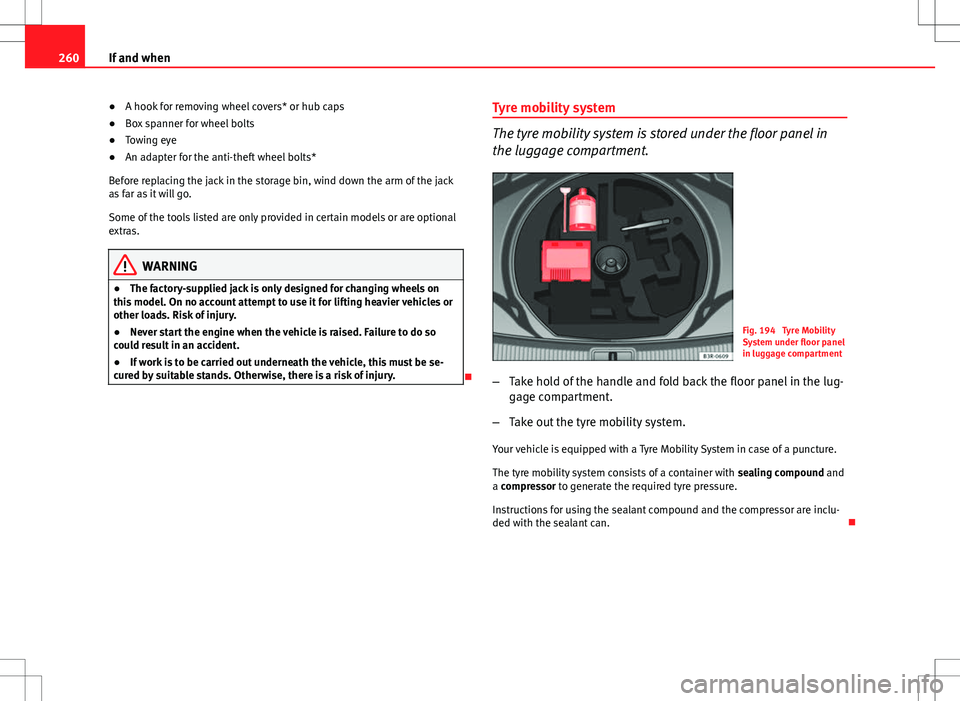
260If and when
● A hook for removing wheel covers* or hub caps
● Box spanner for wheel bolts
● Towing eye
● An adapter for the anti-theft wheel bolts*
Before replacing the jack in the storage bin, wind down the arm of the jack
as far as it will go.
Some of the tools listed are only provided in certain models or are optional
extras.
WARNING
● The factory-supplied jack is only designed for changing wheels on
this model. On no account attempt to use it for lifting heavier vehicles or
other loads. Risk of injury.
● Never start the engine when the vehicle is raised. Failure to do so
could result in an accident.
● If work is to be carried out underneath the vehicle, this must be se-
cured by suitable stands. Otherwise, there is a risk of injury.
Tyre mobility system
The tyre mobility system is stored under the floor panel in
the luggage compartment.
Fig. 194 Tyre Mobility
System under floor panel
in luggage compartment
– Take hold of the handle and fold back the floor panel in the lug-
gage compartment.
– Take out the tyre mobility system.
Your vehicle is equipped with a Tyre Mobility System in case of a puncture.
The tyre mobility system consists of a container with sealing compound and
a compressor to generate the required tyre pressure.
Instructions for using the sealant compound and the compressor are inclu-
ded with the sealant can.
Page 263 of 325

261
If and when
Spare steel rim wheel
The spare steel rim wheel is carried in the wheel well under
the floor panel in the luggage compartment. It is only inten-
ded for temporary use over short distances.
Fig. 195 Spare steel rim
wheel
Taking out the spare wheel
– Turn the plastic knob ⇒ Fig. 195 anticlockwise.
– Take out the spare wheel.
Securing the defective wheel in the spare wheel well
– Place wheel in spare wheel well in the luggage compartment.
– Secure the wheel by turning plastic knob clockwise.
– Replace the floor panel before closing the rear lid.
Your vehicle can be factory-equipped with a spare steel wheel. The spare
wheel does not usually meet the same performance standards as the wheels fitted on the vehicle because of the wheel/tyre dimensions, rubber
composition, tread pattern, etc. Therefore, note the following restrictions:
●
The spare steel wheel is designed only for your vehicle model. Do not
attempt to mount the wheel on any vehicle but your own.
● Your vehicle will have different driving characteristics when the spare
steel rim wheel is mounted ⇒
.
● The spare wheel is only intended for temporary use after having a flat
tyre. Replace the spare wheel with a normal wheel that has the proper tyre
dimensions as soon as possible.
● If the size of the spare steel rim wheel is different to that of the other
wheels, it is unlikely that snow chains suitable for the other wheels will fit it.
WARNING
● After mounting the spare steel rim wheel, the tyre pressure must be
checked and corrected as soon as possible. The tyre pressure must corre-
spond to the vehicle load (consult the table containing the inflation pres-
sures). Otherwise there is danger of causing an accident. Use the highest
tyre pressure as indicated in the table.
● Do not drive faster than 80 km/h, as higher speeds can cause an acci-
dent.
● Avoid heavy acceleration, hard braking and fast cornering, as this
could cause an accident.
Safety FirstOperating InstructionsPractical TipsTechnical Specifications
Page 264 of 325
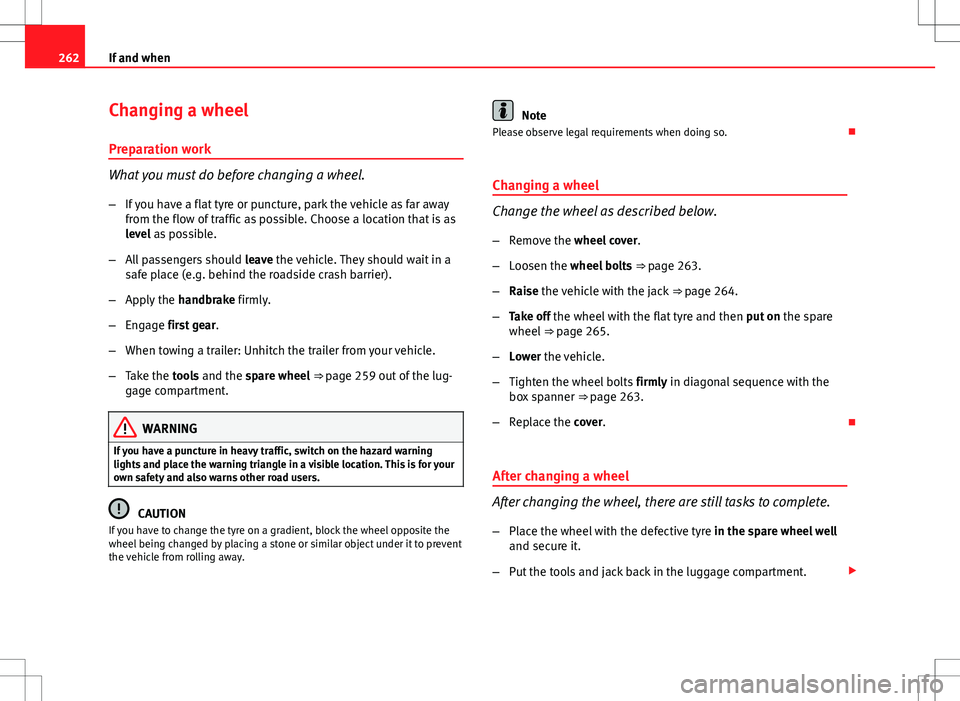
262If and when
Changing a wheel
Preparation work
What you must do before changing a wheel.
– If you have a flat tyre or puncture, park the vehicle as far away
from the flow of traffic as possible. Choose a location that is as
level as possible.
– All passengers should leave the vehicle. They should wait in a
safe place (e.g. behind the roadside crash barrier).
– Apply the handbrake firmly.
– Engage first gear .
– When towing a trailer: Unhitch the trailer from your vehicle.
– Take the tools and the spare wheel ⇒ page 259 out of the lug-
gage compartment.
WARNING
If you have a puncture in heavy traffic, switch on the hazard warning
lights and place the warning triangle in a visible location. This is for your
own safety and also warns other road users.
CAUTION
If you have to change the tyre on a gradient, block the wheel opposite the
wheel being changed by placing a stone or similar object under it to prevent
the vehicle from rolling away.
Note
Please observe legal requirements when doing so.
Changing a wheel
Change the wheel as described below.
– Remove the wheel cover .
– Loosen the wheel bolts ⇒ page 263.
– Raise the vehicle with the jack ⇒ page 264.
– Take off the wheel with the flat tyre and then put on the spare
wheel ⇒ page 265.
– Lower the vehicle.
– Tighten the wheel bolts firmly in diagonal sequence with the
box spanner ⇒ page 263.
– Replace the cover.
After changing a wheel
After changing the wheel, there are still tasks to complete. – Place the wheel with the defective tyre in the spare wheel well
and secure it.
– Put the tools and jack back in the luggage compartment.
Page 265 of 325
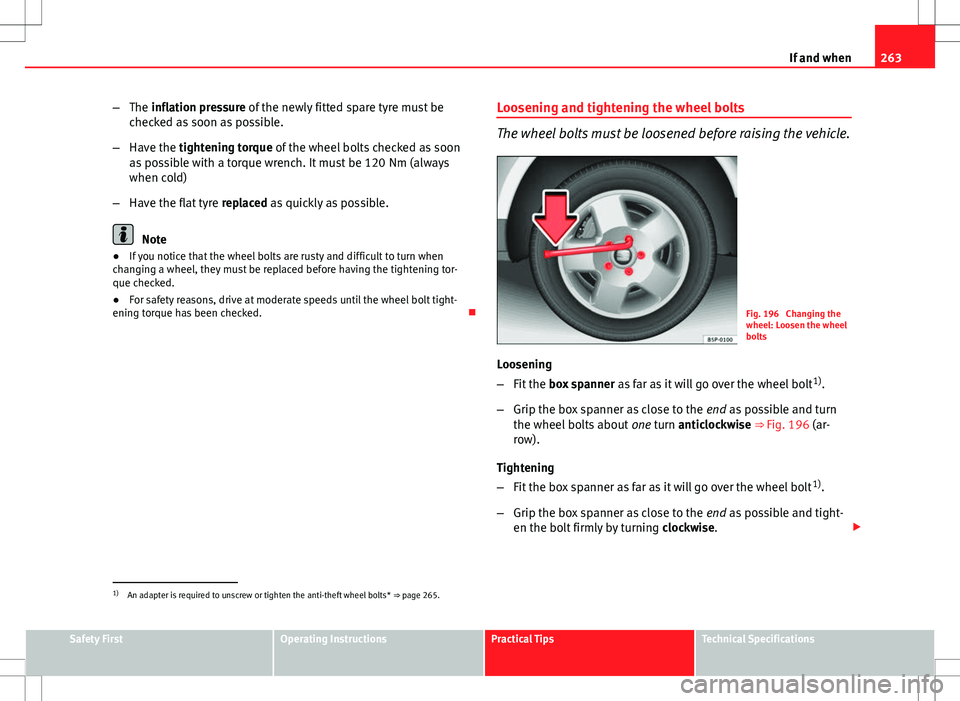
263
If and when
– The inflation pressure of the newly fitted spare tyre must be
checked as soon as possible.
– Have the tightening torque of the wheel bolts checked as soon
as possible with a torque wrench. It must be 120 Nm (always
when cold)
– Have the flat tyre replaced as quickly as possible.
Note
● If you notice that the wheel bolts are rusty and difficult to turn when
changing a wheel, they must be replaced before having the tightening tor-
que checked.
● For safety reasons, drive at moderate speeds until the wheel bolt tight-
ening torque has been checked. Loosening and tightening the wheel bolts
The wheel bolts must be loosened before raising the vehicle.
Fig. 196 Changing the
wheel: Loosen the wheel
bolts
Loosening
– Fit the box spanner as far as it will go over the wheel bolt 1)
.
– Grip the box spanner as close to the end as possible and turn
the wheel bolts about one turn anticlockwise ⇒ Fig. 196 (ar-
row).
Tightening
– Fit the box spanner as far as it will go over the wheel bolt 1)
.
– Grip the box spanner as close to the end as possible and tight-
en the bolt firmly by turning clockwise.
1)
An adapter is required to unscrew or tighten the anti-theft wheel bolts* ⇒ page 265.
Safety FirstOperating InstructionsPractical TipsTechnical Specifications
Page 266 of 325

264If and when
WARNING
Loosen the wheel bolts only about one turn before raising the vehicle
with the jack. Failure to do so could result in an accident.
Note
● If the wheel bolt does not come loose, it may be possible to release it by
pushing down the end of the spanner carefully with your foot. Hold on to the
vehicle for support and take care not to slip.
Raising the vehicle
In order to remove the wheel, the vehicle must be raised
with a jack.
Fig. 197 Changing the
wheel: Jack position
points
Fig. 198 Changing the
wheel: Jack
– Position the vehicle jack under the door sill at the jacking point
closest to the wheel being changed ⇒ Fig. 197 -arrows-.
– Wind up the jack under the jacking point until the claw of the
jack is directly below the vertical rib under the door sill.
– Align the jack so that the arm of the jack fits on the rib under
the door sill ⇒ Fig. 198 A
and the movable base plate of the
jack B is flat on the ground.
– Raise the vehicle until the defective wheel is just clear of the
ground.
Recesses at the front and rear of the door sills mark the jacking points
⇒ Fig. 197 -arrows-. There is only
one jacking point for each wheel. Do not
fit the jack anywhere else.
The distance from the jacking points to the wheel arches is approximately
15 cm at the front and 25 cm at the rear.
Page 267 of 325

265
If and when
An unstable surface under the jack may cause the vehicle to slip off the
jack. Therefore, the jack must be fitted on solid ground offering good sup-
port. Use a large, stable base if necessary. On a hard, slippery surface (such
as tiles) use a rubber mat or similar to prevent the jack from slipping.
WARNING
● Take all precautions so that the base of the jack does not slip. Failure
to do so could result in an accident.
● The vehicle can be damaged if the jack is not applied at the correct
jacking points. There is also a risk of injury since the jack can slip off
suddenly if it is not properly engaged.
Removing and fitting the wheel
For removal and fitting the wheel, the following tasks must
be completed.
After loosening the wheel bolts and raising the vehicle with the
jack, change the wheel as described below:
Removing a wheel
– Unscrew the wheel bolts using the box spanner and place them
on a clean surface.
Fitting a wheel
– Screw on the wheel bolts in position and tighten them loosely
with a box spanner.
The wheel bolts should be clean and easily screwed. Before fitting the spare
wheel, inspect the wheel condition and hub mounting surfaces. These sur-
faces must be clean before fitting the wheel. If tyres with a specific direction of rotation are fitted, note the direction of
rotation.
Anti-theft wheel bolts*
A special adapter is required to turn the anti-theft wheel
bolts.
Fig. 199 Anti-theft
wheel bolt
– Insert the adapter onto the wheel bolt and push it on as far as it
will go ⇒ Fig. 199.
– Fit the box spanner as far as it will go over the adapter.
– Loosen or tighten the wheel bolt as appropriate.
Code
The code number of the anti-theft wheel bolt is stamped onto the front part
of the adaptor.
Safety FirstOperating InstructionsPractical TipsTechnical Specifications
Page 268 of 325

266If and when
The code number should be noted and kept in a safe place, as it is only by
using the code number that a duplicate adaptor can be obtained from the
SEAT Official Services.
Tyres with directional tread pattern
Tyres with directional tread pattern must be fitted so that
they rotate in the correct direction. A directional tread pattern can be identified by arrows on the sidewall that
point in the direction of rotation. Always note the direction of rotation indi-
cated when fitting the wheel. This is important so that these tyres can give
maximum grip and avoid excessive noise, tread wear and aquaplaning.
If, in an emergency, you have to fit the spare wheel so it rotates in the wrong
direction, you must drive extremely carefully. The tyre will not give optimum
performance. This is particularly important when driving on wet roads.
To benefit from the advantages of tyres with this type of tread pattern, the
defective tyre should be replaced as soon as possible so that all tyres again
rotate in the correct direction. Tyre repair* (Tyre-Mobility-System)
General information and safety notes
Repaired tyres are only suitable for temporary use over a
short period.
Fig. 200 The Tyre Mobi-
lity System is not suita-
ble for repairing this type
of damage to tyres.
Your vehicle is equipped with a tyre repair kit: the Tyre Mobility System.
In the event of a puncture you will find the TMS, which consists of a sealing
compound and a compressor, located under the floor panel in the luggage
compartment.
The Tyre Mobility System will reliably seal tyres damaged by foreign bodies,
provided that the cuts or punctures are no larger than approx. 4 mm.
It is not necessary to remove the foreign body from the tyre.
Page 269 of 325
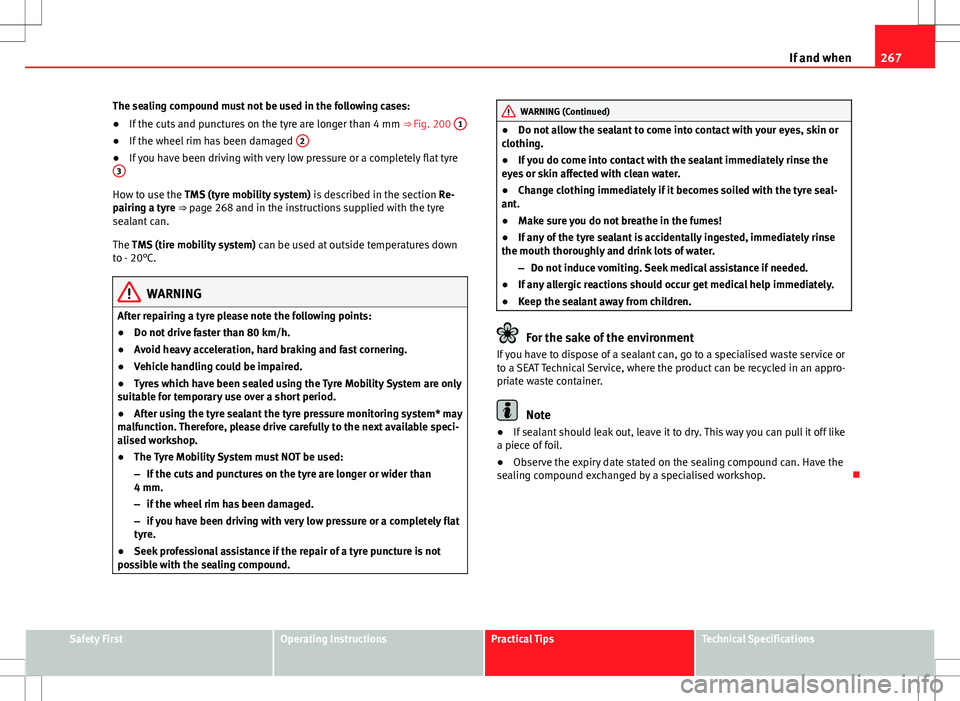
267
If and when
The sealing compound must not be used in the following cases:
● If the cuts and punctures on the tyre are longer than 4 mm ⇒ Fig. 200 1
●
If the wheel rim has been damaged 2●
If you have been driving with very low pressure or a completely flat tyre
3
How to use the TMS (tyre mobility system) is described in the section Re-
pairing a tyre ⇒ page 268 and in the instructions supplied with the tyre
sealant can.
The TMS (tire mobility system) can be used at outside temperatures down
to - 20°C.
WARNING
After repairing a tyre please note the following points:
● Do not drive faster than 80 km/h.
● Avoid heavy acceleration, hard braking and fast cornering.
● Vehicle handling could be impaired.
● Tyres which have been sealed using the Tyre Mobility System are only
suitable for temporary use over a short period.
● After using the tyre sealant the tyre pressure monitoring system* may
malfunction. Therefore, please drive carefully to the next available speci-
alised workshop.
● The Tyre Mobility System must NOT be used:
– If the cuts and punctures on the tyre are longer or wider than
4 mm.
– if the wheel rim has been damaged.
– if you have been driving with very low pressure or a completely flat
tyre.
● Seek professional assistance if the repair of a tyre puncture is not
possible with the sealing compound.
WARNING (Continued)
● Do not allow the sealant to come into contact with your eyes, skin or
clothing.
● If you do come into contact with the sealant immediately rinse the
eyes or skin affected with clean water.
● Change clothing immediately if it becomes soiled with the tyre seal-
ant.
● Make sure you do not breathe in the fumes!
● If any of the tyre sealant is accidentally ingested, immediately rinse
the mouth thoroughly and drink lots of water.
–Do not induce vomiting. Seek medical assistance if needed.
● If any allergic reactions should occur get medical help immediately.
● Keep the sealant away from children.
For the sake of the environment
If you have to dispose of a sealant can, go to a specialised waste service or
to a SEAT Technical Service, where the product can be recycled in an appro-
priate waste container.
Note
● If sealant should leak out, leave it to dry. This way you can pull it off like
a piece of foil.
● Observe the expiry date stated on the sealing compound can. Have the
sealing compound exchanged by a specialised workshop.
Safety FirstOperating InstructionsPractical TipsTechnical Specifications
Page 270 of 325
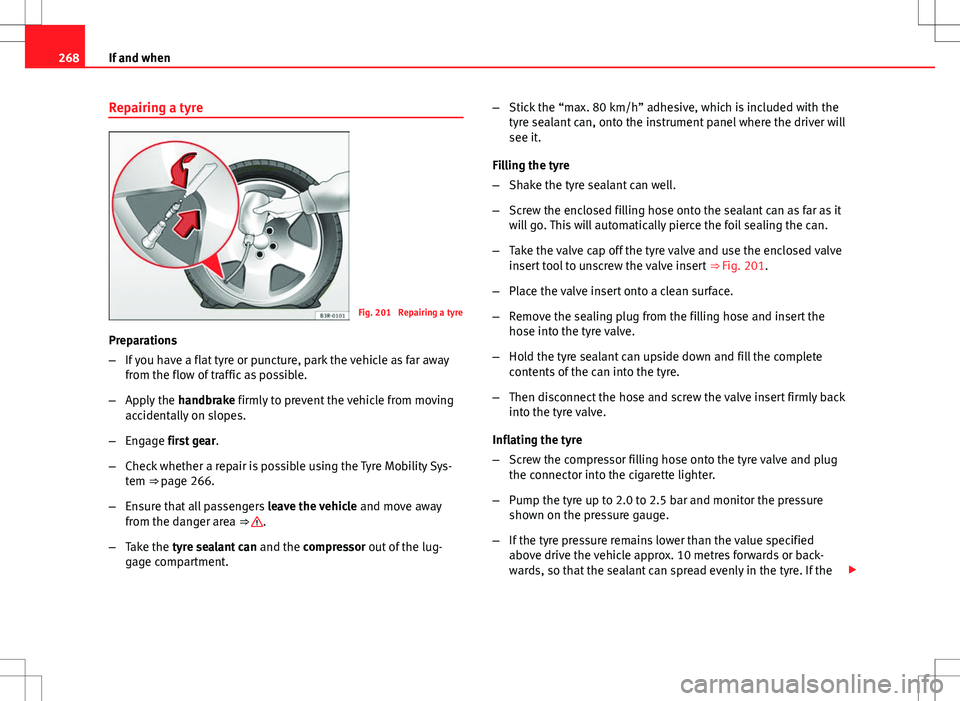
268If and when
Repairing a tyre
Fig. 201 Repairing a tyre
Preparations
– If you have a flat tyre or puncture, park the vehicle as far away
from the flow of traffic as possible.
– Apply the handbrake firmly to prevent the vehicle from moving
accidentally on slopes.
– Engage first gear .
– Check whether a repair is possible using the Tyre Mobility Sys-
tem ⇒ page 266.
– Ensure that all passengers leave the vehicle and move away
from the danger area ⇒
.
– Take the tyre sealant can and the compressor out of the lug-
gage compartment. –
Stick the “max. 80 km/h” adhesive, which is included with the
tyre sealant can, onto the instrument panel where the driver will
see it.
Filling the tyre
– Shake the tyre sealant can well.
– Screw the enclosed filling hose onto the sealant can as far as it
will go. This will automatically pierce the foil sealing the can.
– Take the valve cap off the tyre valve and use the enclosed valve
insert tool to unscrew the valve insert ⇒ Fig. 201.
– Place the valve insert onto a clean surface.
– Remove the sealing plug from the filling hose and insert the
hose into the tyre valve.
– Hold the tyre sealant can upside down and fill the complete
contents of the can into the tyre.
– Then disconnect the hose and screw the valve insert firmly back
into the tyre valve.
Inflating the tyre
– Screw the compressor filling hose onto the tyre valve and plug
the connector into the cigarette lighter.
– Pump the tyre up to 2.0 to 2.5 bar and monitor the pressure
shown on the pressure gauge.
– If the tyre pressure remains lower than the value specified
above drive the vehicle approx. 10 metres forwards or back-
wards, so that the sealant can spread evenly in the tyre. If the